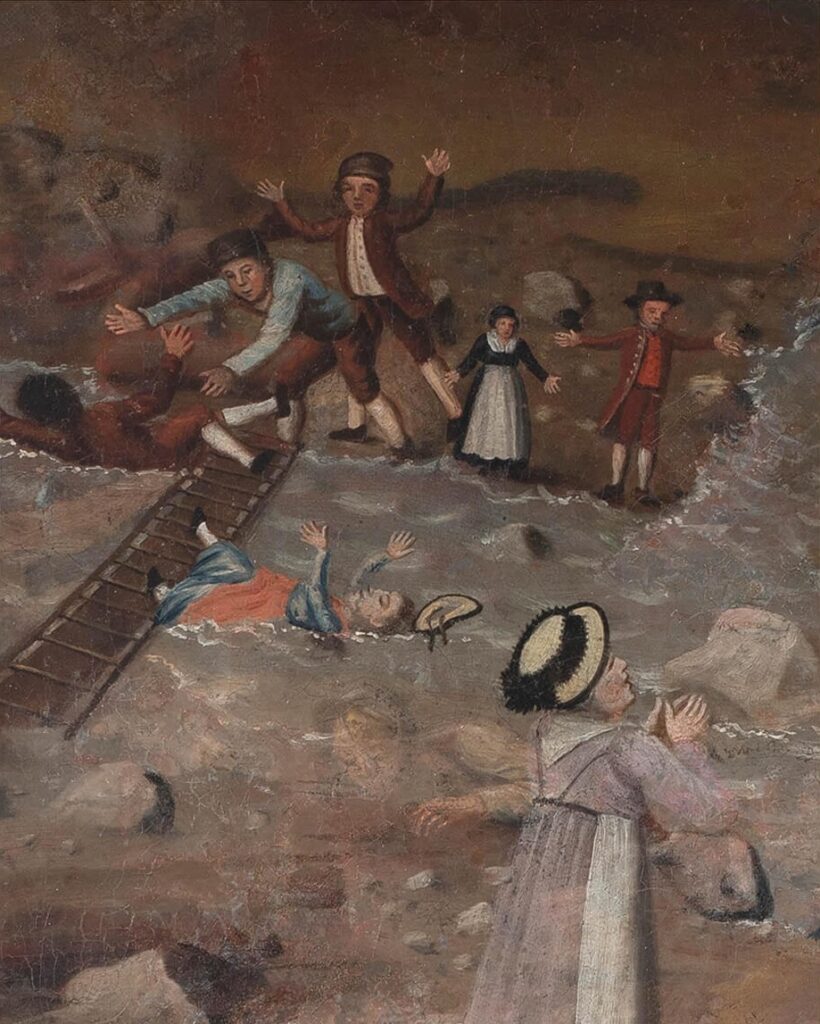Etienne Wismer
Glaciers do not only consist of ice. In their porous spaces, they contain mineral particles, oxygen, and, ultimately, snow and water. Carl Ludwig Hackert’s Vue de la Source de l’Arveron (1781) shows a glacier crisscrossed by meltwater streams and numerous erratic blocks (Fig. 1). Hackert’s depiction embodies the iconography of alpine glacier landscapes in eighteenth- and early nineteenth-century France and Switzerland, which coincided with the emergence of the first glaciological studies and the “discovery of the Alps” by a European elite.[1]
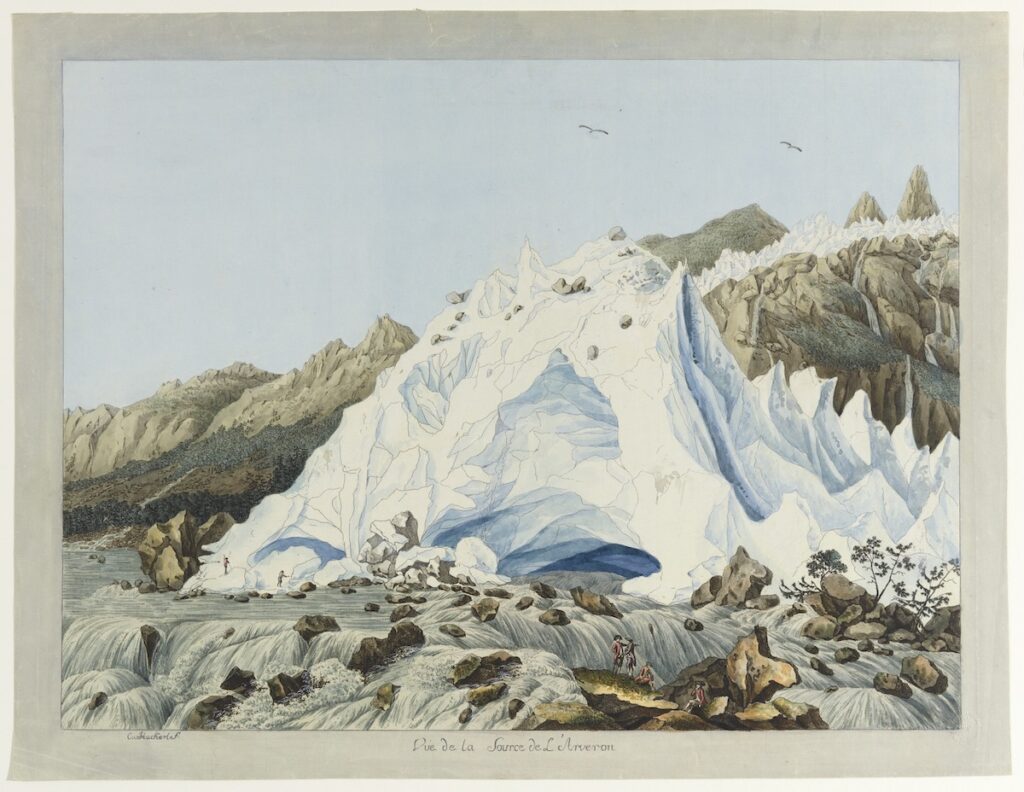
Hackert’s imagery accommodates, on the one hand, the public’s common demands for glacier depictions around 1780: rough, icy structures, deep crevasses, and the sheer enormity of the ice masses.[2] However, it likewise elucidates that glaciers are by no means static and amorphous entities. Rather, they are complex structures, deeply imbricated in a multitude of temporalities and spatialities. In the image, a bubbling water spring is placed centrally around the glacier gate, in a grotto set in deep blue. These ice masses are shown to be in constant change. They melt, shrink, mix with spring water, pour down into the valley, freeze again higher up, and continue to expand. In view of Hackert’s depiction, one can ask where the glacier begins and where it ends.
In this short essay, I would like to emphasize the latter aspect and reflect on the dissolution of glaciers as an occasion to think about their range. In Hackert’s depiction, the spring and meltwater pours over the entire lower third of the picture, flowing quietly at times, roaring at others. It forms an outwash plain typical of glaciers, overgrown with moss, small trees, and shrubbery. The glacier gives birth to its own fragile ecosystem.[3] How can we grasp the relationship between a glacial biotope and humans? Accordingly, what objects are helpful to us in this endeavor, and what does this selection eventually tell us? Further, who benefits from the dissolution of glaciers, and who does it harm? The glacier’s field of action, I argue, extends beyond its primary settlement, generally at higher elevations. It reaches valleys, cities, and, finally, living rooms.
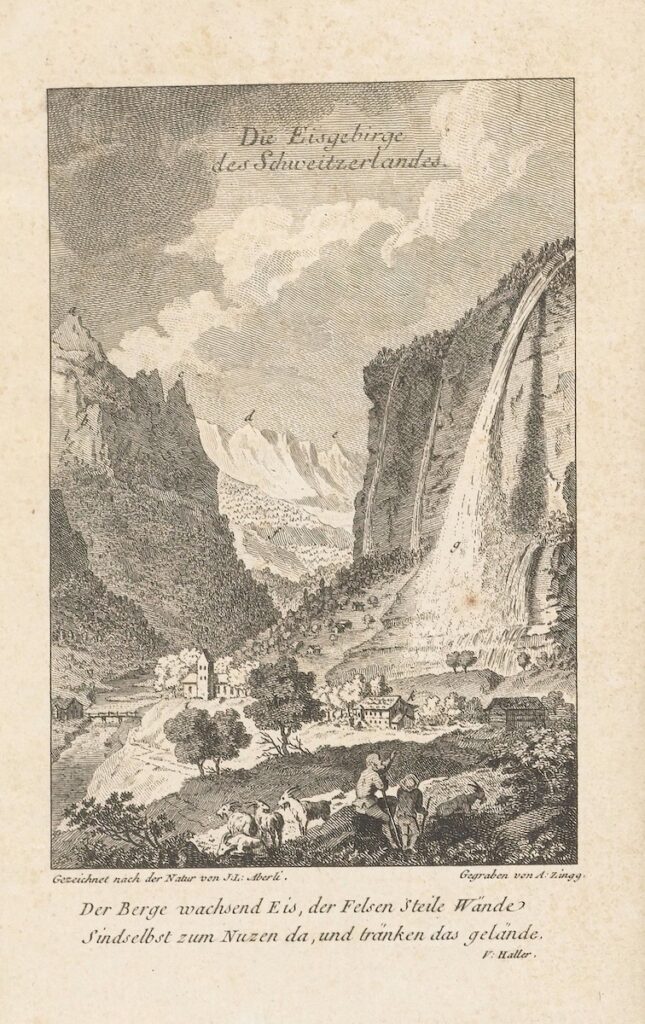
Glaciers act as mobile, fluid, and disruptive masses. As such, they are significant terraformers. Throughout their movement, they forge drumlins, moraines, and valleys. Thus they are not only features of the mountain landscape, but active shapers of it. The frontispiece to Gottlieb Sigmund Gruner’s (1717–1778) first volume of The Ice Mountains of Switzerland, published from 1760 onwards, takes place in the Lauterbrunnen Valley—a valley whose characteristic U-shape and high vertical rock faces indicate its glacial origin (Fig. 2). In the image, the ice from the glacial period has long since disappeared. The illustration emphasizes the spectacularly pouring Staubbach Falls on the right rather than the glacier in the background. At various points in his text, though, the author emphasizes the usefulness of glaciers. These “purify the air as well as maintain the course of the rivers.”[4] The frontispiece is underlaid with an excerpt from Albrecht von Haller’s poem “The Alps” from 1729, underlining that glaciers ensure, mutatis mutandis, the supply of water to the pasture lands. A herd of goats grazing on a luscious green meadow provides pictorial evidence of this statement. Current research supports this claim: the regime of the river flowing downstream is mainly affected by melted ice and snow. About 20% of the river’s watershed is therefore glaciated.[5]
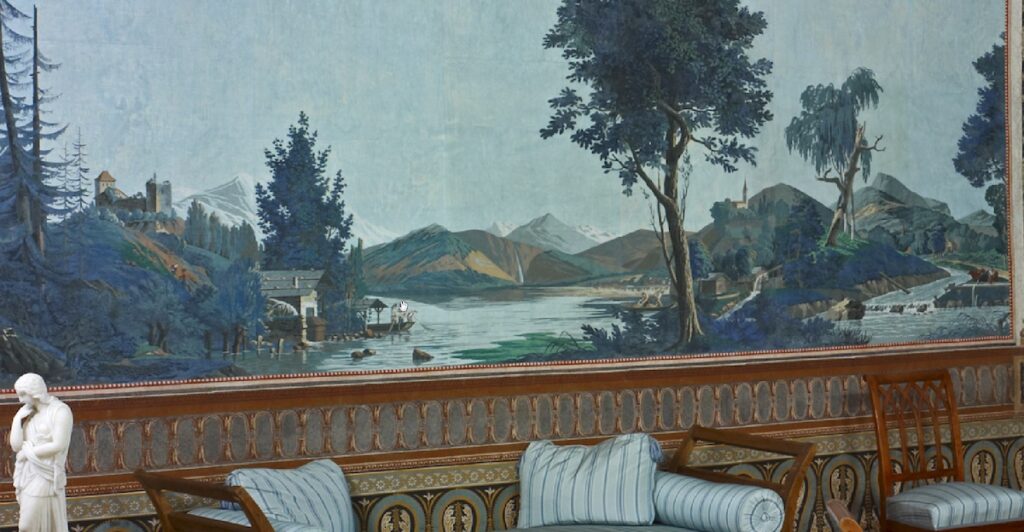
Meltwater from glacial areas has a key impact on the flow regime of streams and rivers. Ultimately, it contributes a substantial share to the rising level of standing water.[6] Late eighteenth-century travel guides indicate that visiting places regularly hit by floods and diseases was part of the program of a tourist trip through Switzerland.[7] Numerous tide gauges built during this period in Switzerland—in Vevey (1780), Geneva (1806), Zurich (1810), and Neuchâtel (1817)—demonstrate the need to have knowledge of the water levels.[8] The devastating floods that hit the pre-Alpine areas of that time, however, hardly found their way into visual culture. We nevertheless find such a scene in a scenic wallpaper by the Alsatian manufacturer Zuber (Vues de Suisse, first commercialized in 1802) (Fig. 3). This wall decoration of up to 10 by 2 meters displays a composed Swiss landscape. It features a glacier as well as alpine waterfalls, rushing rivers, and grazing cows. The view extends into the lakes of the lowlands and therefore points out the interconnectedness between wetscapes.
While peppered with travel highlights and charming iconography, the wallpaper also provides a scene for a silent catastrophe. The shores of the lake in the center are flooded: houses, trees, and shrubs are under water. Before we go into this account in greater detail, some basic considerations are required about the way in which glaciers move—and have been moved. A large part of the dynamics of glaciers is due to the viscosity of the ice, to its own weight, or to gravity. But people also increasingly impact on its mobility, by transforming a troubling material into a manageable, even useful one. By the 1820s, ice had become an international commodity shipped between the United States and India, linking the frozen North with the tropical South.[9] In Central Europe, the trade in ice developed after the 1830s, with the increasing availability of faster, steam-powered modes of transport. In both cases, however, it should be noted that the transport of glacial ice always involved the transport of meltwater, for large parts of the ice melted away on long journeys.
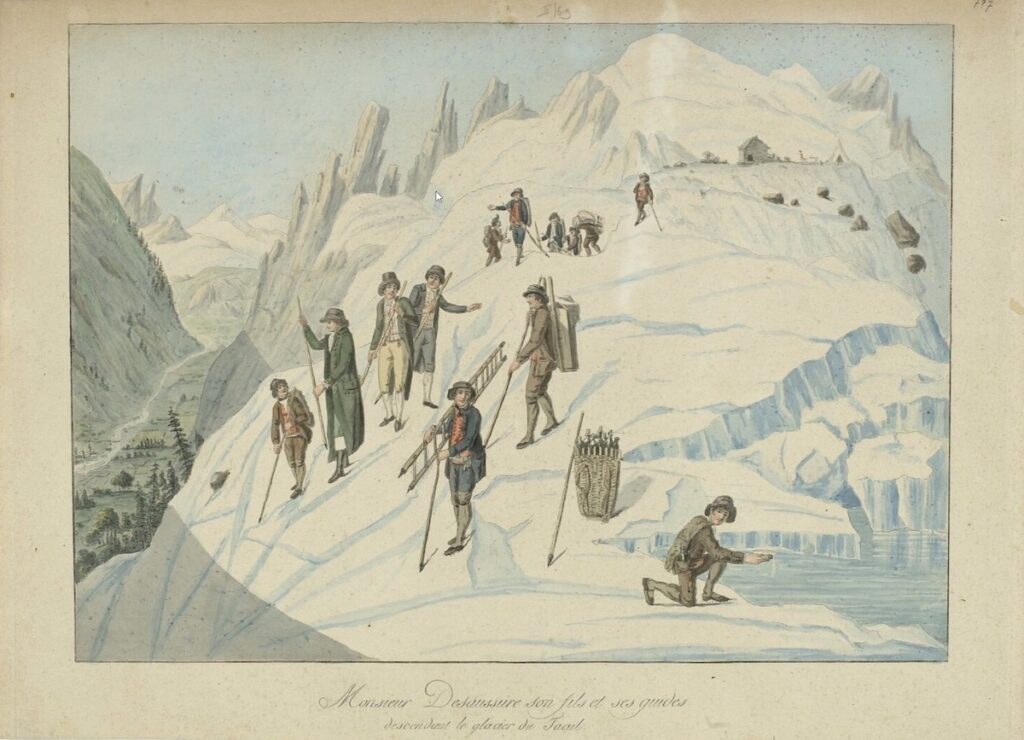
The circulation of actual glacial water, nonetheless, occurred within the context of Alpine geologic sampling. Henri L’Evêque’s pre-1790 illustration of Horace Bénédict de Saussure’s multi-day stay on the Tacul Glacier shows an alpinist scooping icy water from a glacial lake (Fig. 4). There is a bottle in his jacket pocket, as well as in the carrying basket placed behind him. Even if the purpose of his collection, as well as the origin of the fillings of the other bottles, remain unclear, it can be said that water is probably being bottled and taken back to the valley, most likely as a research sample, just as the group around De Saussure carried out all kinds of minerals. While De Saussure gives an extensive account of the searching and collecting of minerals, the taking of water samples remains unmentioned.[10] It is thanks to the author of the picture—who knew the equipment and the experiments to be carried out by the expedition group and perhaps even participated in them himself—that this seemingly anecdotal action has been documented. His interest is directed to the equipment of the group: the walking sticks, ladders, and carrying devices and thus also their contents, the flacons.

In fact, it is its mineral content that leads to the commodification of glacier water years before its appropriation for scientific purposes. This fluid, also known as glacial milk or rock flour, was considered to treat fever, diarrhea, and headaches. Gruner’s publication, as well as Diderot and d’Alembert’s Encyclopédie (1757), discuss and emphasize its curative effects.[11] It is thanks to the publication Description of the Nature and Forces of the Swiss Glacier Spiritus (1758) that we know of glacier water also being distributed as a pharmaceutical (Fig. 5). The book singles out its many qualities, namely the ones cited by Gruner, and puts the spotlight on its reportedly “most distinguished and powerful” ingredient, “glacier salt.”[12] Its author, Daniel Langhans, also handled the production and the distribution of the Glacier Spiritus. From a medical point of view however, the product was the subject of serious criticism, with suspicions that the highly praised glacier water was nothing more than saltpeter and kitchen salt.[13]
The success of the Glacier Spiritus was largely due to making the glacier physically, but also figuratively, consumable. The so-called goat’s whey cure (Geiss-Schotten-Kur), or the later eighteenth-century penchant for therapeutic baths, are further examples of how the alpine landscape was medically and therapeutically linked and commodified.[14] Pure, light air, which was believed to be contained in the glacier ice in concentrated form, and the aforementioned salt would transfer the glacier’s qualities to the consumer in a healing way through ingestion. The attempt to essentialize glaciers in terms of their meltwater contributed to a massive increase in the range and circulation of the substance. The demand for it seems to have been considerable in Switzerland, but also in Germany and England.[15]
However, by connecting glacier water to healing, there was a failure to recognize that it may have been detrimental to human health. An ex-voto dated June 1818 shows a man being rescued from the raging waters of a stream filled with glacial water (Fig. 6). Shortly before that, an ice dam broke on the Giétro glacier in the Val de Bagne. This flood did not happen slowly, nor was it related to the season. It occurred suddenly and unexpectedly. About 20 million cubic meters of glacial water poured into the valley on June 16, 1818. The flood killed 44 people and destroyed villages, fields, and forests.[16] This event was unique in that it originated in another global event: the eruption of the Indonesian volcano Tambora three years earlier, in 1815, followed by a volcanic winter in the northern hemisphere, and a “year without summer” in 1816.[17]
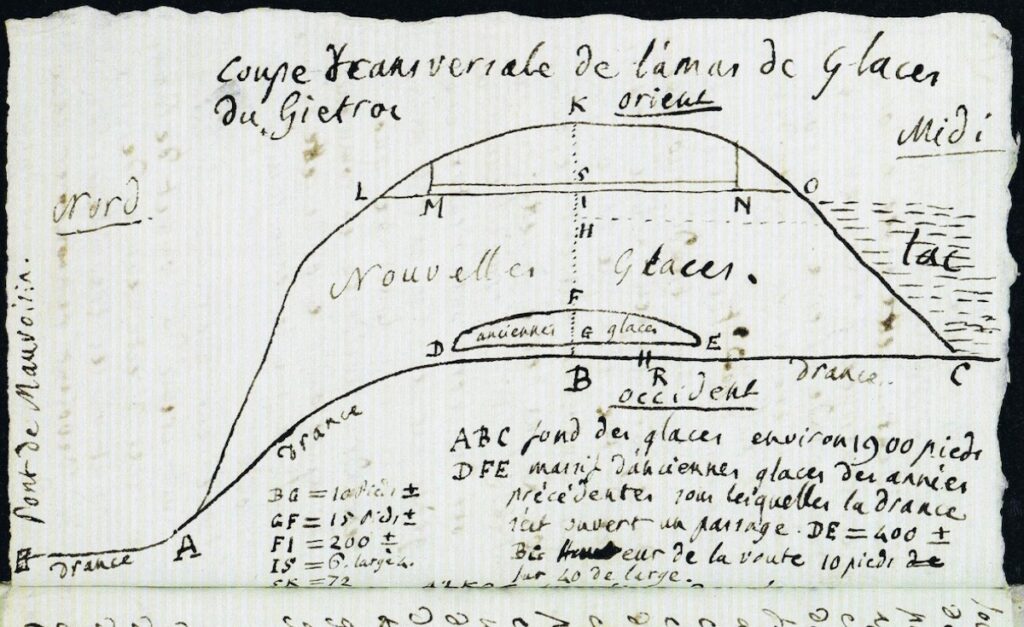
As a local consequence, the Giétro glacier naturally increased and advanced over a cliff. Masses of ice that broke off from it dammed every possible means of drainage through the valley. A sketch probably drawn on site shows the situation at the glacier (Fig. 7). Whereas the actual glacier is missing, we do find in the center of this representation the collapsed ice masses as well as the retained meltwater to the left. To reduce the risk of dam failure, the meltwater was to be drained off through a tunnel running across the iceberg. This project was subjected to the same reformist and elitist view as the numerous watercourse corrections and deswamping projects of the time.[18] Amelioration activities were started at the source, and no exception was made for meltwater.[19] The dam broke even before the work could be completed. The aforementioned ex-voto shows ravaged shore zones and the lurid strength of the water’s flow (Fig. 6). The dynamics of the glacier are visible with full force. This is not a solid glacier, but a liquid, dissolved, and raging mass.[20] At the lower edge of the bank, a submerged body appears to be pulled down by the blue-gray water and mud.
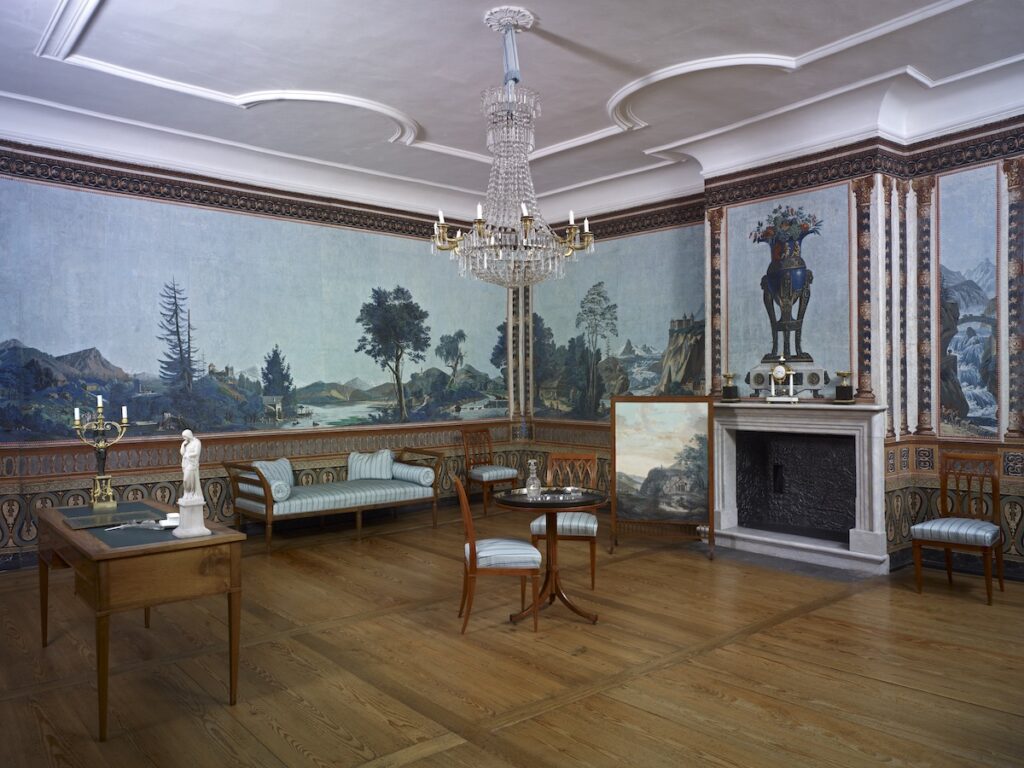
Here meltwater no longer nourishes or heals. It is also no longer observed or administered. Instead, it becomes an agent and itself consumes. It is through the lens of consumption and dissolution that I will conclude my argument. To this end, I once again refer to the wallpaper mentioned above. In 1804, Imperial Countess Luise von Hochberg (1768–1820) depicted this disaster on the walls of Schwetzingen Palace, located near the Rhine. The décor, which survives today, shows how the scenic wallpaper was inserted into existing room structures (Fig. 8). The placement of the single glacier is of particular interest. It was pasted to the immediate left of the fireplace. Especially on cold days spent indoors, the sight of the opposition between frozen ice and blazing fire might have left a “pleasant” yet at the same time “imaginative” impression on sitters in the room.[21] The depicted flood could be recreated here as a result of the heat effect of the fire. The evocative interplay of architectural frame and interior design took place no more than three meters apart, between the chimney, the glacier, and the flooded lakeshore.
This spatial experience of melting as a process mirrors the temporal dimension involved in the change of aggregate state from ice to water (or vice versa). Ice forms and changes over the period of days, years, decades, and millennia. The melting process, on the other hand, is brief by comparison. A few warm days suffice to swell glacial streams and endanger the environment. The spatial setting created by Luise von Hochberg visually allows the cold and the heat to “shake hands.” On the grandest scale, it bridged the elements, and, by doing so, underlined the idea of a landscape in constant motion. To a certain extent, we may also allude to human control over the elements.
Interdisciplinary analysis of image material from the long eighteenth century has determined that more than half of the alpine glacier area of 1760 had since melted away.[22] Yet this visual material remains relevant beyond this point. By examining natural and cultural imaginaries of an “endangered species,” we are able to combine and understand processes of circulation and transformation.[23] In both a figurative and physical sense, meltwater brings the climatological, geological, and cultural glacial matter from top to bottom—from the mountain to the cities, and to living rooms. By pursuing this assertion, a heterogeneous selection of historical objects emerged, in our case book illustrations, written sources, medicinal remedies, sacral imagery, technical drawings, and interior décor. Their analysis enables the circulation of ice and meltwater to be understood as a complex, disruptive process of ecological factors combined with the human domestication of natural resources.
Etienne Wismer is a doctoral candidate in Art History at the University of Bern, Switzerland
[1] Simona Boscani Leoni, “The Discovery of the Alps: Between ‘Science’ and Exoticism,” in Exotic Switzerland?Looking Outward in the Age of Enlightenment, ed. Claire Brizon, Chonja Lee, Etienne Wismer, and Noémie Etienne (Zurich: Diaphanes, 2020), 285–97.
[2] Matthias Oberli, “Von ‘Wunder-Bergen’ und ‘Colossalischen Schreckensäulen’. Die Entdeckung der Gletscher in der Schweizer Kunst des 17. und 18. Jahrhunderts,” in Wissenschaft, Sentiment und Geschäftssinn. Landschaft um 1800, ed. Roger Fayet, Regula Krähenbühl, and Bernhard von Waldkirch (Zurich: Swiss Institute for Art Research, 2017), 32–55.
[3] Ice humanities. Living, working, and thinking in a melting world, ed. Klaus Dodds and Sverker Sörlin (Manchester: Manchester University Press, 2022), 33.
[4] Gottlieb Sigmund Gruner, The Ice Mountains of Switzerland, 3 vols. (Bern: Abraham Wagner Sohn, 1760), 3:178–82.
[5] “Hydro-CH2018,” National Centre for Climate Services, https://hydromaps.ch/#en/ (all web links accessed February 2, 2023).
[6] According to World Glacier Monitoring Service, meltwater accounts for 25 to 30 percent of the currently observed increase in global sea levels. “Contribution to sea-level rise,” World Glacier Monitoring Service, https://wgms.ch/sea-level-rise/.
[7] Johann Gottfried Ebel, Anleitung auf die nützlichste und genussvollste Art die Schweitz zu bereisen (Zurich: Orell, Gessner, Füssli & Compagnie, 1793/1805), 243, https://www.e-rara.ch/zut/doi/10.3931/e-rara-9809.
[8] Daniel L. Vischer, Die Geschichte des Hochwasserschutzes in der Schweiz. Von den Anfängen bis ins 19. Jahrhundert (Bern: Berichte des BWG, 2003), 32.
[9] Maggie M. Cao, “The Entropic History of Ice,” Ecologies. Agents. Terrains, ed. Christopher P. Heuer and Rebecca Zorach (New Haven: Yale University Press, 2018), 266–91, 274.
[10] Horace Bénédict de Saussure, Voyages dans les Alpes (Neuchâtel: Samuel Fauche, 1779-96).
[11] Paul Henri Thiry d’Holbach, “Glaciers ou Gletschers,” Encylopédie, 28 vols. (Paris: Briasson, 1751–1765), vol. 7, 692; Gruner, The Ice Mountains of Switzerland, 3:179.
[12] Daniel Langhans, Description of the Nature and Forces of the Swiss Glacier Spiritus […], (Zurich: Heidegger und Compagnie, 1758), 3, https://doi.org/10.3931/e-rara-19453.
[13] Sascha Müller and Tina Asmussen, “Gletscher im Flacon,” in Montan-Welten. Alpengeschichte abseits des Pfades, ed. Tina Asmussen (Zurich: Intercom Verlag, 2019), J4.
[14] Barbara Orland, “Alpine Landscapes of Health: The Swiss Whey Cure and Therapeutic Tourism between 1750 and 1870,” in Connecting Territories. Exploring People and Nature, 1700–1850, ed. Simona Boscani Leoni, Sarah Baumgartner, and Meike Knittel (Leiden: Brill, 2021), 212; François de Capitani, “Gesunde Schweiz. Der Gesundheitsdiskurs in der Aufklärung,” in Zauber-Berge und heile Welten: die Schweiz als Gesundheits-Paradies, ed. Felix Graf and Eberhard Wolff (Baden: Hier und Jetzt, 2010), 15–7.
[15] Müller and Asmussen, “Gletscher im Flacon,” J4.
[16] The events were reviewed in Giétro 1818. Sous la loupe des sciences, ed. Sophia Cantinotti and Jean-Henry Papilloud (Martigny: Société d’histoire du Valais Romand, 2019).
[17] Stefan Brönnimann, Daniel Krämer, “Tambora and the ‘Year Without a Summer’ of 1816. A Perspective on Earth and Human Systems Science,” Geographica Bernensia G90: 20, https://doi:10.4480/GB2016.G90.01.
[18] Martin Stuber and Matthias Bürgi, Vom ‘eroberten Land’ zum Renaturierungsprojekt. Geschichte der Feuchtgebiete in der Schweiz seit 1700 (Bern/Stuttgart/Vienna: Haupt, 2018), 19–43.
[19] The Giétroz glacier was the concern of elite engineering experts of the time, including Ignaz Venetz and Hans Konrad Escher of Linth.
[20] Jemma Wadham, Ice Rivers: A Story of Glaciers, Wilderness, and Humanity (Princeton: Princeton University Press 2021), 7.
[21] The sales brochure of the Dufour manufactory, published at the same time, praises the appearance of the wallpaper, according to which “the beholder will constantly have a pleasant vision of the ensemble,” and emphasizes how it gave “new enjoyment to the fantasy.” [Joseph Dufour], Les sauvages de la mer pacifique (Mâcon: Moiroux, 1804), 8–9.
[22] Heinz J. Zumbühl, Daniel Steiner, and Samuel U. Nussbaumer, “Nineteenth-Century Glacier Representations and Fluctuations in the Central and Western European Alps: An Interdisciplinary Approach,” Global and Planetary Change 60, 1-2 (January 2008): 54, https://doi.org/10.1016/j.gloplacha.2006.08.005; Heinz J. Zumbühl, “’Der Berge wachsend Eis’: die Entdeckung der Alpen und ihrer Gletscher durch Albrecht von Haller und Caspar Wolf,” Mitteilungen der Naturforschenden Gesellschaft Bern 66 (2009): 129. Since the turn of the millennium, the Alpine region’s glaciers have lost around one-sixth of their total volume due to global climate change. See Christian Sommer et al., “Rapid Glacier Retreat and Downwasting Throughout the European Alps in the Early 21st Century,” Nature Communications 11 (2020): 2, https://doi.org/10.1038/s41467-020-16818-0.
[23] Mark Carey, “The History of Ice: How Glaciers Became an Endangered Species,” Environmental History 12, 3 (July 2007): 497–527, https://doi.org/10.1093/envhis/12.3.497.
Cite this article as: Etienne Wismer, “Making Sense of Ice? Engaging Meltwater in the Long Eighteenth Century in Switzerland and France,” Journal18, Issue 16 Cold (Fall 2023), https://www.journal18.org/6996.
Licence: CC BY-NC
Journal18 is published under a Creative Commons CC BY-NC International 4.0 license. Use of any content published in Journal18 must be for non-commercial purposes and appropriate credit must be given to the author of the content. Details for appropriate citation appear above.

